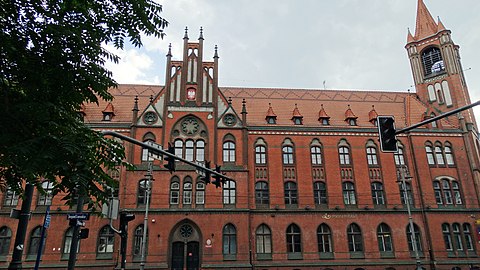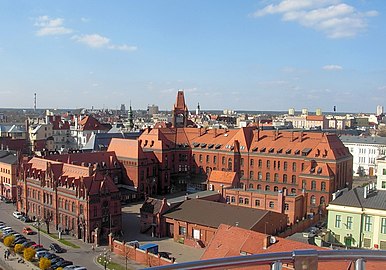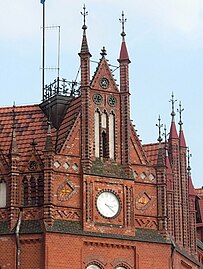Main Post Office, Bydgoszcz
| Main Post Office | |
|---|---|
Poczta Polska | |
| Technical details | |
| Material | brick |
| Floor count | 4 |
| Design and construction | |
| Architect(s) | Boettger, Kleinfeldt, Neumann |
| Website | |
| Bydgoszcz-poczta-glowna | |
The Main Post Office in Bydgoszcz is a complex of historical post buildings, owned by
Location
Buildings stand on a plot delimitated by the following streets:
History
Ancient period
The existence of royal mail institutions royal in Bydgoszcz dates back to the first half of 18th century, as confirmed by postal statutes of the Crown General Post in 1733, 1754 and 1766.[2] In 1751, the post office in Bydgoszcz was in a bourgeois building on the corner of Niedźwiedzia and Stefan Batory Streets near the Old Marketplace.
After the
First post office building
In 1815 Prussian authorities assigned the former stables to the needs of Royal Prussian Post Office Directorate in Bydgoszcz. The new post office was then located in the corner of the streets
Gottfried Groschke, longtime director (1815-1847), had been designated in 1840 "Honorary Citizen of
Second post office building
Upon the establishment of a Higher Directorate of Post in Bydgoszcz, the initial edifice on Jagiellońska street could no longer fully meet the needs of a new, enlarged administration coordinating the mail work in the city and throughout the Bydgoszcz region: there was a real need to get a building that could manage both activities, mail and telegraphy. By the end of the 1850s, on-site stables and coach houses were built according to the design of building inspector Bannenschmidt. The construction standing in the corner of Jagiellońska and Pocztowa streets displayed Neo-Classicist features.
In 1859, the post office also housed the activities of the Municipal Central Tax Office (
Third post office building
After 1871's victory during Franco-Prussian War and the improved financial condition of Kingdom of Prussia, Prussian authorities decided to expand the mail institution network across the country. In this context, it has been planned to erect a new building designed for offices, mail and telegraph on a plot along the Brda river, still property of the military administration: in 1870s, an old guardhouse had been liquidated, but other buildings were still standing, like a residential and wattle and daub fire station.
In 1879, the area was purchased to construct the new post edifice, which was unveiled on September 1, 1885. Plans and drawings were the work of several authors, including Mr Boettger, government building master. The architectural design was dictated by Prussian parliament rules, such as Neo-Gothic bricks, considered as a Prussian national style, the use of rooms and courtyards, the height of premises fences over 4 m, etc.[2]
Clinker bricks for the construction have been brought from Malbork's Brick and Ceramic Factory. On the first floor were the telegraph machinery, the telephone room and the battery storage. The wing along the Brda river were dedicated for housing allowances for postal workers. The main entrance to the courtyard stood on river side and its ornated gate survived preserved till today.[2]
Fourth post office building
After 10 years of activity of the post office building, a need appears for a new one dedicated entirely to the Imperial Directorate of Posts, with its constantly expanding amount of offices works (mail, telegraph and phone), and a multitude of civil servants. Another plot was acquired, with land and buildings between
Building progress was overseen by inspector Wolff, on behalf of postal officials Döhring and Schwerkotting. The building was completed in 1900, the masonry work has been mainly led by
The postal building ensemble has survived in its 1899 initial shape almost unchanged to this day with its original windows and doors, its massive frame structures in the hallways, the cross vaulted corridors and staircases, the original metal railings and some ceramic floors. Only interior spaces have been transformed to fit a modern and functional activity. The building continues to serve as the Main Post Office of Bydgoszcz.[2]
Architecture
Main Post Office buildings complex is built in the so-called "Prussian national style", which was in force in the last decades of the 19th century, and required for every new official buildings in the German Empire. It alludes to the Northern German Neo-Gothic style, which, however, also refers to other styles such as Italian and German Neo-Renaissance, Neo-Romanesque, Round-arch style -invoking the Romanesque and Byzantine architecture- and Spitzbogenstil -with scrolling Dutch and Gothic elements.[2]
Old building (Stary Port Street Wing)
The building is brick-made, with one storey, an attic and a basement.[4] It has two wings with slight avant-corps: one is parallel to the river, the other one covers half the length of Pocztowa street. The pentagonal tower in the courtyard shelters a staircase.[4] The bare briked facades are, in places, supplemented with greenish or maroon glazed ones, displaying a more decorative nature. Glazed details draw attention to the regular friezes, pinnacles, traceries on the one hand and the geometric pattern thread embedded in the wall on the other hand.The richness of ceramics detail, wrought iron decorative elements are also remarkable.[4]
The facades on the riverside present biforium and
The view of the rear façade is alike the front but in a more simplified and devoid of color friezes or glazed details.[4] The passage of time, acts of war and inappropriate reconstruction work resulted in the loss of part of the decoration on the facades of the building. In the corner is preserved a surviving metal frame structure where was mounted the cable network of telegraph and telephone, topped with an ornate flèche from the date of construction of the facility "1885".[4]
New building (Jagiellońska street Wing)
This building has a "U" shape with a massive body giving onto
The construction has three-storey, with an attic and a basement. Prominent avant-corps are noticeable from Jagiellońska street, lowerones are present on Pocztowa's facade. The ensemble is covered by a gable roof with embedded dormers.[4] The decoration of the facade is simplified in comparaison with the older building, but the same decorative repertoire is partly repeated. It uses wimpergs, pinnacles, pointed arches, arched windows and portals, along with a diverse combination of brick traceries, iron rose window and color friezes with rhythmically repetitive arrangements of red and green glazed bricks.[4]
Buildings have been registered on the
Gallery
-
View from the river
-
Facade onto Jagiellońska St.
-
View from the river bank
-
Bird eye view
-
Tower on Jagiellońska st.
-
Gable roof on the old building
-
Detail on the arched portal (notice the inscription "Eingang 3")
-
Detail of adorned roofs
-
Glazed mosaic
-
Portal
-
By night
See also
- Bydgoszcz
- Jagiellońska street in Bydgoszcz
- Gdańska Street, Bydgoszcz
- Stary Port Street in Bydgoszcz
- Brda river
References
- ^ a b POWIATOWY PROGRAM OPIEKI NAD ZABYTKAMI POWIATU BYDGOSKIEGO NA LATA 2013-2016. Bydgoszcz: Kujawsko-pomorskie. 1 March 2014.
- ^ a b c d e f g h i j k l m n Winter, Piotr (1997). Dawne bydgoskie budynki pocztowe i z pocztą związane. Bydgoszcz: Materiały do Dziejów Kultury i Sztuki Bydgoszczy i Regionu zeszyt 2. Pracownia Dokumentacji i Popularyzacji Zabytków Wojewódzkiego Ośrodka Kultury w Bydgoszczy.
- ISBN 83-85327-27-4.)
{{cite book}}: CS1 maint: location missing publisher (link - ^ a b c d e f g h Parucka, Krystyna (2008). Zabytki Bydgoszczy – minikatalog. Bydgoszcz: „Tifen” Krystyna Parucka.
Bibliography
- (in Polish) Umiński, Janusz (1996). Bydgoszcz. Przewodnik. Bydgoszcz: Regionalny Oddział PTTK „Szlak Brdy”.
- (in Polish) Winter, Piotr (1997). Dawne bydgoskie budynki pocztowe i z pocztą związane. Materiały do Dziejów Kultury i Sztuki Bydgoszczy i Regionu, zeszyt 2. Bydgoszcz: Pracownia Dokumentacji i Popularyzacji Zabytków Wojewódzkiego Ośrodka Kultury w Bydgoszczy.













